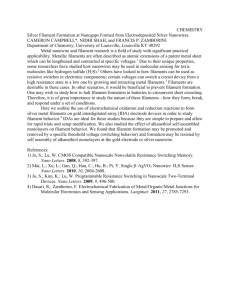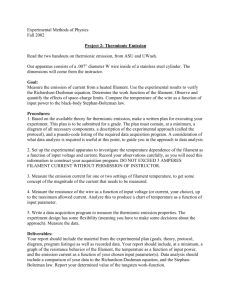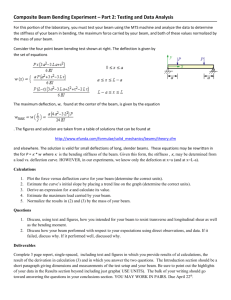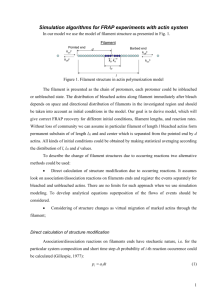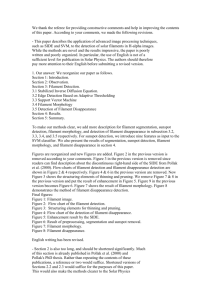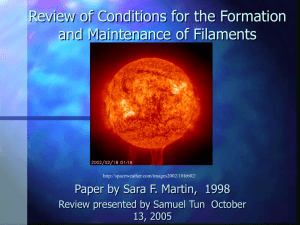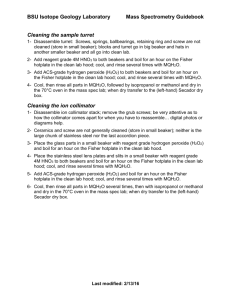Text S1: The Biophysical Properties of Filaments
advertisement
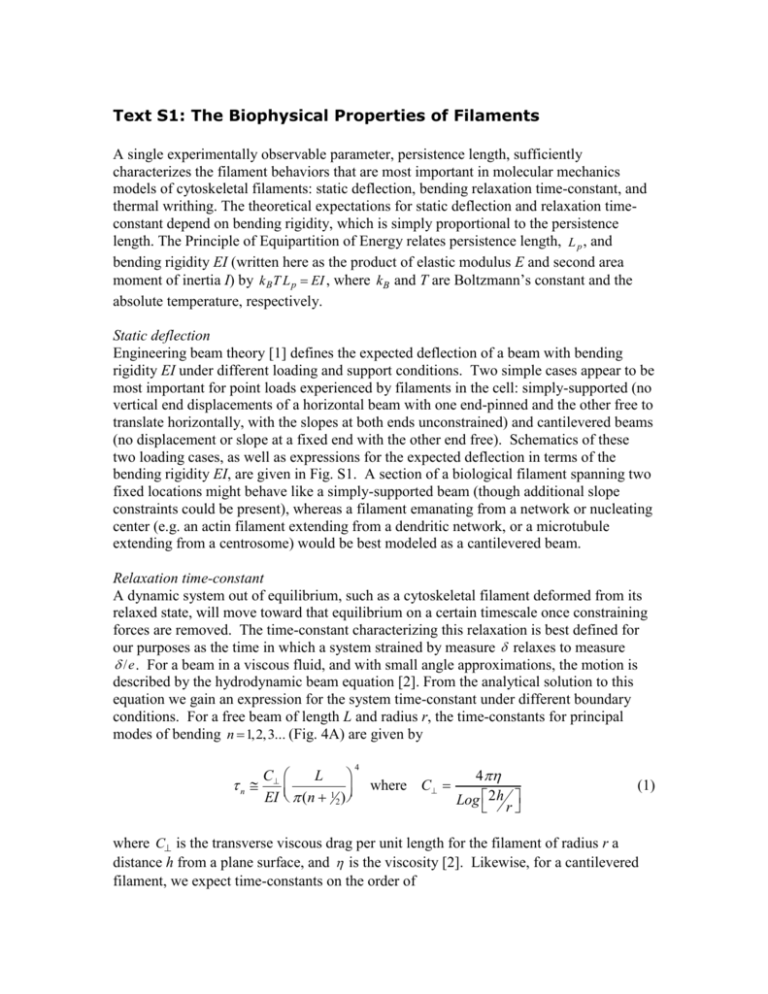
Text S1: The Biophysical Properties of Filaments
A single experimentally observable parameter, persistence length, sufficiently
characterizes the filament behaviors that are most important in molecular mechanics
models of cytoskeletal filaments: static deflection, bending relaxation time-constant, and
thermal writhing. The theoretical expectations for static deflection and relaxation timeconstant depend on bending rigidity, which is simply proportional to the persistence
length. The Principle of Equipartition of Energy relates persistence length, L p , and
bending rigidity EI (written here as the product of elastic modulus E and second area
moment of inertia I) by k BT L p EI , where kB and T are Boltzmann’s constant and the
absolute temperature, respectively.
Static deflection
Engineering beam theory [1] defines the expected deflection of a beam with bending
rigidity EI under different loading and support conditions. Two simple cases appear to be
most important for point loads experienced by filaments in the cell: simply-supported (no
vertical end displacements of a horizontal beam with one end-pinned and the other free to
translate horizontally, with the slopes at both ends unconstrained) and cantilevered beams
(no displacement or slope at a fixed end with the other end free). Schematics of these
two loading cases, as well as expressions for the expected deflection in terms of the
bending rigidity EI, are given in Fig. S1. A section of a biological filament spanning two
fixed locations might behave like a simply-supported beam (though additional slope
constraints could be present), whereas a filament emanating from a network or nucleating
center (e.g. an actin filament extending from a dendritic network, or a microtubule
extending from a centrosome) would be best modeled as a cantilevered beam.
Relaxation time-constant
A dynamic system out of equilibrium, such as a cytoskeletal filament deformed from its
relaxed state, will move toward that equilibrium on a certain timescale once constraining
forces are removed. The time-constant characterizing this relaxation is best defined for
our purposes as the time in which a system strained by measure relaxes to measure
/e . For a beam in a viscous fluid, and with small angle approximations, the motion is
described by the hydrodynamic beam equation [2]. From the analytical solution to this
equation we gain an expression for the system time-constant
under different boundary
conditions. For a free beam of length L and radius r, the time-constants for principal
modes of bending n 1,2, 3... (Fig. 4A) are given by
C
L
n
EI (n 1 2 )
4
where C
4
Log 2h r
(1)
where C is the transverse viscous drag per unit length for the filament of radius r a
distance h from a plane surface, and is the viscosity [2]. Likewise, for a cantilevered
filament, we expect time-constants on the order of
n
C L4
EI n4
n (n 12 )
where
(2)
Thermal writhing
writhe as random thermal forces impinge,
A flexible filament
immersed in a fluid will
adopting a curved shape at any given instant. Before its bending rigidity straightens it,
new thermal forces will cause it to bend into a new randomly curved shape. Thus, the
filament will never come to rest. This writhing is experimentally described for biological
filaments such as actin filaments and microtubules [3]. In addition, the entire filament is
subject to diffusional translation and rotation. A measure of the degree of these thermally
induced bending deformations is the filament’s “persistence length” --the arc length over
which the time-averaged cosine of the angle between path tangents is 1/ e . Precisely, for
a filament with persistence length L p , the time average angular correlation between path
tangent vectors is
s / Lp
u˜ 0 u˜ s e
(3)
where u˜0 and u˜ s are path tangent vectors at points separated by arc length s , the dot
denotes a vector inner product, and the brackets denote a long time-average.
A molecular mechanics model of a filament would waste too much
computer time to
simulate explicitly the bombardment by an enormous number of water molecules; we
instead encapsulate the ensuing deformation and bulk movement with a few randomly
directed forces and torques. For a rigid body, and in the direction of any of the three
principle geometric axes {x, y, z} along which its diffusivity is D , the mean
displacement is zero and the root-mean-square displacement during time interval t is
2D t . That is, its random walk displacements for a sequence of steps of duration t ,
2D t . Unless the
come from a Gaussian
distribution with zero mean and variance
object is a sphere or cube or similar shape with simple symmetries, the diffusivity D is
generally different for each principle axis. The case is even more complicated for a
segmented body, such as our in silico representation of
cytoskeletal filament, but for
filaments much shorter than the persistence length L p , such as each of the rigid segments
in the model of Fig. 2, the bulk Brownian movement can be well approximated by that of
a rigid body of the same shape.
References
1. Shigley JE, Mischke CR, Budynas R (2004) Mechanical Engineering Design. New
York, McGraw-Hill. 1030p.
2. Howard J (2001) Mechanics of Motor Proteins and the Cytoskeleton. Massachusetts,
Sinauer. 370p.
3. Gittes F, Mickey B, Nettleton J, Howard J (1993) Flexural rigidity of microtubules and
actin filaments measured from thermal fluctuations in shape. J Cell Biol 120: 923-34.

